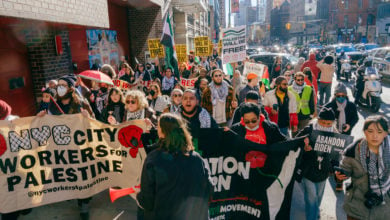 The U.S. Senate is full of millionaires and 97 percent white. That’s democracy?
Photo: Ron Sachs/CNP
|
The word “democracy” comes from the Greek words “demos”—the people—and “kratos”—rule, and therefore means “rule of the people.” As a political form, it is commonly understood as majority rule.
For centuries, the U.S. government has upheld itself as the most advanced expression and international defender of democracy. It has launched wars and invasions in the name of democracy. But there are different types of democracy, so what type exists in the United States?
The earliest European system commonly called a democracy was in Athens, Greece around 2,500 years ago. In a city of 100,000 people, however, it is estimated that less than 10 percent of the population voted. Only men who had completed their military obligations and who were full citizens could participate. The system excluded women, immigrants (metics) and the more than half the population who were slaves.
In a government based on the “rule of the people,” it was really a minority ruling class that decided who constituted “the people.”
Much like the democracy of ancient Greece, U.S. “democracy” was founded by slave owners. It too excluded women and enslaved people, and initially gave voting rights only to men who owned property. As of 1787, the property-owning requirement to run for political office was so stringent that most voters did not even qualify as candidates. So the owning class used property ownership requirements to create a “democracy” that concentrated political decision-making power in their own hands.
Since the founding of the United States, popular struggles have torn down exclusionary voting requirements. State after state eliminated their property qualifications for white male voters in the first half of the 19th century, with South Carolina being the last to do so in 1860. A powerful suffragist movement won white women the right to vote in 1920. African Americans defeated Jim Crow voting restrictions in the Civil Rights movement of the 1960s, winning the Voting Rights Act in 1965.
But as this aspect of the democratic system—voting requirements—has been opened, the U.S. ruling class has carefully adjusted the political system so that informal rather than formal requirements keep power in the hands of the rich property owners. A bipartisan political system offers the appearance of a choice—between two parties that fundamentally agree on the supremacy of the corporate exploiters at home and imperialist exploitation abroad.
For instance, rather than formally requiring someone to be worth a certain dollar amount in order to run for office, as it was in 1787, candidates now must be able to raise tens of millions of dollars in order to run their campaigns. It is basically an informal requirement that one must be rich to win political office.
There have only been three African American senators since post-Civil War Reconstruction ended in 1877. Nearly half of current senators are officially millionaires. The real number is probably higher. There is not one worker in the U.S. Senate. It is hardly a representative body.
Moreover, only the inessential parts of the U.S. political system are subject to the vote and majority rule. You do not get to vote on your wages or benefits. You do not get to vote on whether the company you work for should lay off workers. You do not get to vote on whether the country should go to war, or if it should cut spending on social programs. There may be a vote taken on these issues, but it is a vote amongst millionaires in the corporate boardrooms and the halls of Congress.
Marxists call this kind of “democracy” under capitalism “bourgeois democracy”—the democracy of the owning class. No matter the outcome of any given vote, the continued rule of the capitalist system is guaranteed.
In a society divided into social classes, words like democracy only have a meaning in the context of actual class relations—democracy for which class?
When the African American community, still suffering from systematic disenfranchisement, calls for democracy in the United States, that is something very different than the right-wing Cuban exiles in Miami who clamor for “democracy” in Cuba—a country where working people have more political and social rights than in any advanced capitalist country in the world. The former aims to extend rights to more working people, while the latter aims to take rights away.
The basis for working-class democracy
Is there an alternative to this democracy for the rich? The practical basis for constructing a new type of democracy is very simple. Whether in Ancient Greece or in modern capitalism, a minority class has controlled society’s wealth and decision-making powers. “Majority rule” is a lie as long as a tiny minority holds the vast majority of the wealth.
Under capitalism, the economy is not subjected to the will of the majority. It is driven by the quest for profits. Decisions are made by individuals and groups of individuals on the basis of how and where to maximize their personal profits.
A democratic society would be organized so that the people have decision-making power over how to use the wealth of society, which is produced collectively. Subjecting the economy to conscious decision-making and to majority rule—in other words, bringing the economy into the realm of democracy—is called a planned economy. It is a basic principle of socialism.
The single biggest obstacle to this real democracy in the United States is the tiny elite of corporate owners and bankers—the capitalist class. Expropriating the wealth of the capitalist class and using it to meet the needs of society would lay the basis for genuine working class democracy.





